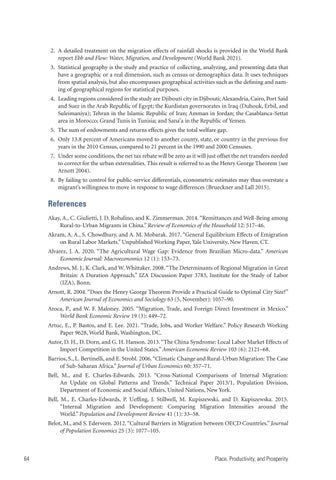2. A detailed treatment on the migration effects of rainfall shocks is provided in the World Bank report Ebb and Flow: Water, Migration, and Development (World Bank 2021). 3. Statistical geography is the study and practice of collecting, analyzing, and presenting data that have a geographic or a real dimension, such as census or demographics data. It uses techniques from spatial analysis, but also encompasses geographical activities such as the defining and naming of geographical regions for statistical purposes. 4. Leading regions considered in the study are Djibouti city in Djibouti; Alexandria, Cairo, Port Said and Suez in the Arab Republic of Egypt; the Kurdistan governorates in Iraq (Duhouk, Erbil, and Suleimaniya); Tehran in the Islamic Republic of Iran; Amman in Jordan; the Casablanca-Settat area in Morocco; Grand Tunis in Tunisia; and Sana’a in the Republic of Yemen. 5. The sum of endowments and returns effects gives the total welfare gap. 6. Only 13.8 percent of Americans moved to another county, state, or country in the previous five years in the 2010 Census, compared to 21 percent in the 1990 and 2000 Censuses. 7. Under some conditions, the net tax rebate will be zero as it will just offset the net transfers needed to correct for the urban externalities. This result is referred to as the Henry George Theorem (see Arnott 2004). 8. By failing to control for public-service differentials, econometric estimates may thus overstate a migrant’s willingness to move in response to wage differences (Brueckner and Lall 2015).
References Akay, A., C. Giulietti, J. D. Robalino, and K. Zimmerman. 2014. “Remittances and Well-Being among Rural-to-Urban Migrants in China.” Review of Economics of the Household 12: 517–46. Akram, A. A., S. Chowdhury, and A. M. Mobarak. 2017. “General Equilibrium Effects of Emigration on Rural Labor Markets.” Unpublished Working Paper, Yale University, New Haven, CT. Alvarez, J. A. 2020. “The Agricultural Wage Gap: Evidence from Brazilian Micro-data.” American Economic Journal: Macroeconomics 12 (1): 153–73. Andrews, M. J., K. Clark, and W. Whittaker. 2008. “The Determinants of Regional Migration in Great Britain: A Duration Approach.” IZA Discussion Paper 3783, Institute for the Study of Labor (IZA), Bonn. Arnott, R. 2004. “Does the Henry George Theorem Provide a Practical Guide to Optimal City Size?” American Journal of Economics and Sociology 63 (5, November): 1057–90. Aroca, P., and W. F. Maloney. 2005. “Migration, Trade, and Foreign Direct Investment in Mexico.” World Bank Economic Review 19 (3): 449–72. Artuc, E., P. Bastos, and E. Lee. 2021. “Trade, Jobs, and Worker Welfare.” Policy Research Working Paper 9628, World Bank, Washington, DC. Autor, D. H., D. Dorn, and G. H. Hanson. 2013. “The China Syndrome: Local Labor Market Effects of Import Competition in the United States.” American Economic Review 103 (6): 2121–68. Barrios, S., L. Bertinelli, and E. Strobl. 2006. “Climatic Change and Rural-Urban Migration: The Case of Sub-Saharan Africa.” Journal of Urban Economics 60: 357–71. Bell, M., and E. Charles-Edwards. 2013. “Cross-National Comparisons of Internal Migration: An Update on Global Patterns and Trends.” Technical Paper 2013/1, Population Division, Department of Economic and Social Affairs, United Nations, New York. Bell, M., E. Charles-Edwards, P. Ueffing, J. Stillwell, M. Kupiszewski, and D. Kupiszewska. 2015. “Internal Migration and Development: Comparing Migration Intensities around the World.” Population and Development Review 41 (1): 33–58. Belot, M., and S. Ederveen. 2012. “Cultural Barriers in Migration between OECD Countries.” Journal of Population Economics 25 (3): 1077–105.
64
Place, Productivity, and Prosperity

